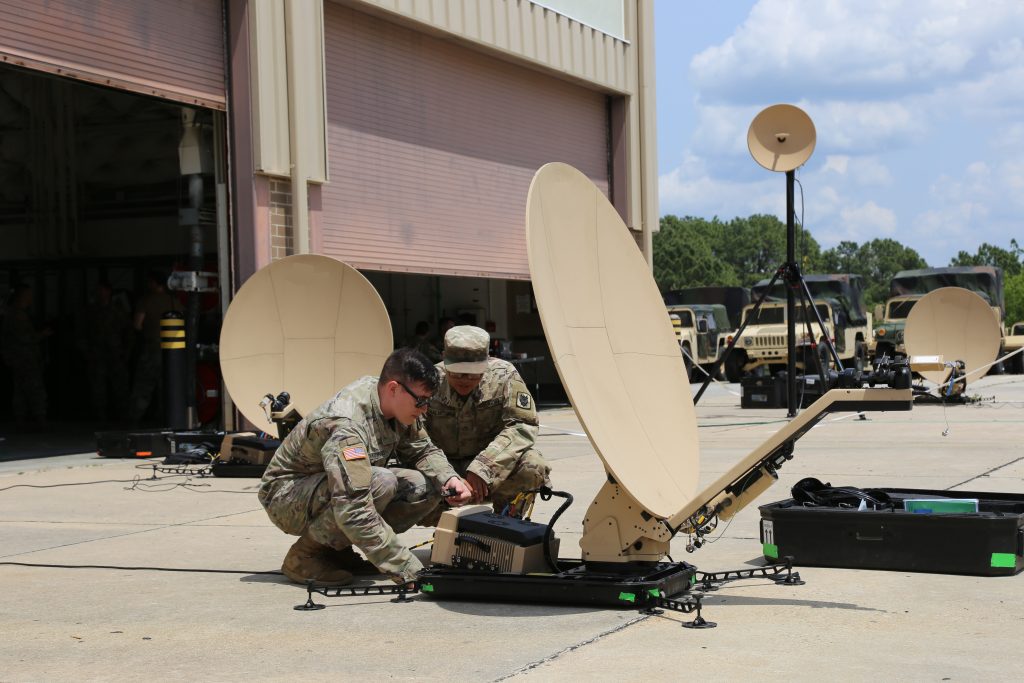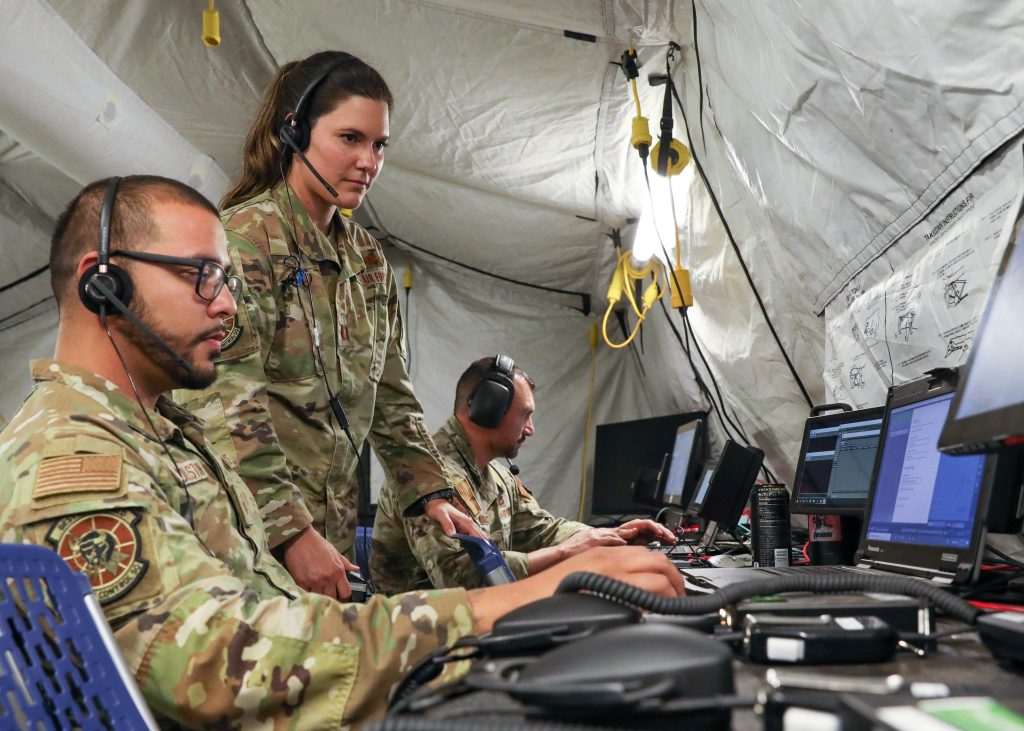
RECONNAISSANCE ROTATION: A Soldier from 25th Infantry Division conducts field reconnaissance Oct. 31 on Pohakuloa Training Grounds, Hawaii. (Photo by Sgt. Daniel Proper, 25th Infantry Division)
Future operating environment, strategic need fuel Army’s network design goals.
by Amy Walker
The Army’s design goals for its unified network of 2030 are shaped to tackle some tough challenges: large-scale ground combat operations, near-peer adversaries and a complex globally distributed and electronic warfare-contested battlefield—all as the pace of technology accelerates with increasing speed.
To retain U.S. decision dominance, the Army, joint service and industry stakeholders are collectively fleshing out potential solutions to be successful in this complex future operating environment.
“Near-peer threats operate in cyberspace at a very high level, and we need to acknowledge that and build a network that enables [joint] and coalition operations, with the flexibility to maneuver it and to defend it,” said Lt. Gen. John Morrison, U.S. Army deputy chief of staff G-6, during his keynote address at the Army’s Technical Exchange Meeting (TEM) 9 in Nashville, Tennessee, in December 2022. “Figuring out how to share intelligence so that we all clearly understand the threat and the environment is going to be absolutely critical for all of us moving forward—not as an Army, not as an industry company, but as a nation.”
The TEM was the ninth in a series of semiannual meetings that provide continuous transparency with industry on Army network priorities and strategy. Industry will take feedback from this event to help scope research and development (R&D) investment and eventual proposals to help shape the Army’s network capability sets (CS). TEM 9 highlighted several key focus areas that support the Army’s digital transformation and future network, including data centricity, agnostic and resilient network transport, zero trust architecture, and unified network operations and management. The two-day event focused on the Army’s network modernization CS-25 and CS-27 design goals, as well as the supporting acquisition approaches, such as the ongoing Capability Portfolio Review and new business models such a Satellite Communications (SATCOM) as a Service. TEM X is planned for May in Philadelphia.
The Army uses its two-year incremental capability set process to execute network modernization across the force while keeping pace with technology advancements and emerging threats. Each capability set builds off the previous and is infused with commercial solutions informed by Soldier touch points, global experimentation, and developmental and operational tests that are synchronized and combined for maximum efficiency and effectiveness.
“The Army is now three years into the capability set fielding and development process and we have strong momentum,” said Maj. Gen. Anthony “Tony” Potts, program executive officer for Command, Control, Communications ‒ Tactical (PEO C3T). “To deliver usable actionable data to commanders, when and where they need it, we need a network transport that is modular, scalable and tailorable. We have to make it easier for our signal officers to set up multiple transport layers. We also want to understand where we can spread across [network] layers to be smarter about the way we use the bandwidth that is available.”
The Army’s network community works on several capability sets at a time. While currently fielding CS-23, the Army is simultaneously prototyping and experimenting for CS-25, and maturing science and technology (S&T) efforts for CS-27 and beyond.
CS-21, which already has been fielded, focused on expeditionary and intuitive capabilities for infantry formations at brigade and below. Building on CS-21 foundation, CS-23 focuses on network capacity, resilience and convergence, and CS-25 furthers automation and protected network capabilities. CS-23 and beyond target network modernization for mounted formations, as well as networking the division formation.

SCALABLE SET UP: Soldiers from the 50th Expeditionary Signal Battalion-Enhanced set up a scalable network node satellite terminal during the Army Cyber Command Software Defined-Wide Area Networking pilot in May 2022 at Fort Bragg, North Carolina. (Photo by Amy Walker, Project Manager Tactical Network)
CS-25: AUTOMATED AND PROTECTED
CS-25 is moving from the prototyping and experimental phase to the system design and development phase, which begins with the CS-25 Preliminary Design Review in April 2023. This review will ensure alignment of requirements, enabling technology, acquisition and funding to help ensure a successful transition from S&T to programs of record.
CS-25 solutions will help deliver data at the point of need, through the integration and enhancement of numerous capabilities, such as the new Command Post Integrated Infrastructure; resilient transport-agnostic network capabilities that incorporate initial high-throughput, low-latency multi-orbit SATCOM and automatic primary, alternate, contingency and emergency (Auto-PACE) solutions to reduce Soldier burden; and more robust cloud capability. CS-25 also advances the Army’s tactical data fabric and C5ISR/Electronic Warfare Modular Open Suite of Standards, which enables the Army to insert cards embedded with networked capabilities.
Soldiers will plan and manage the CS-25 unified network through an integrated set of Unified Network Operations (UNO) software tools and begin to use zero trust data security principles through UNO’s Identity Credentialing and Access Management software.

THIS IS WARFARE: Military service members assigned to the 7th Air Support Operations Squadron, Fort Bliss, Texas, and 729th Air Control Squadron, Hill Air Force Base, Utah, conduct warfare operations at the Technical Operation Center-Lite on Oct. 14 during Project Convergence 22 experimentation at March Air Reserve Base, California. (Photo by Spc. Brenda Salgado Morales, Army Futures Command)
CS-27 AND BEYOND: MULTIDOMAIN CAPABLE
Key CS-27 design goals evolve multi-path signal diversity, Auto-PACE, data-centric network transport capabilities and modern security architecture. Major advancements include spectrum efficiency across dismounted and mounted platforms, and a unified network that blurs the lines between the traditional lower and upper tier tactical networksringing them together through seamless multi-path transport networking.
CS-29 design goals plan to move the Army from coalition mission partner networking to a true mission partner environment, where units do not have to set up a new network with every new mission. Fully operational tactical data fabric that converges mission command applications onto a “single pane of glass” and adheres to zero trust principles will further enhance secure and relevant data exchange with joint and coalition partners. CS-29 will also increase usage of cloud services in a tactical environment, further enabling distribution of warfighter applications. Other CS-29 design goals will enhance line-of-sight and beyond-line-of-sight on-the-move communications and waveform spectrum efficiency.
“We have done a good job in aligning our S&T to program transitions, which have been very supportive in the delivery of the Army 2030. As we’re looking ahead toward the design of Army 2040, we’re going to stay aligned from an S&T perspective, but we’re also going to get a lot more agile,” said Joe Welch, U.S. Army Combat Capabilities Development Command C5ISR Center director, assigned to Army Futures Command. “We’re putting a plan together, but we’re [also] making sure that we are able to react quickly as commercial developments accelerate, to be able to modify that plan and make sure that we adhere to our ability to stay agile in the S&T space.”

ON-THE-MOVE PILOT: During the Army’s three-week Armored Formation On-The-Move Network Pilot, 1st Lt. T.J. Allen, the communications and network officer assigned to the 6th Squadron, 8th Calvary Regiment, 2nd Armored Brigade Combat Team, 3rd Infantry Division, communicates on Feb. 7, 2022, with brigade headquarters from inside his network-integrated tracked vehicle at a remote location at Fort Stewart, Georgia. (Photo by Amy Walker, Project Manager Tactical Network)
CONCLUSION
As it evolves with each capability set, the Army expects to retain several key attributes in the network of 2030 and 2040: transport-agnostic, data-centric, modern security architecture and cyber electromagnetic activities dominance. Although the service expects these attributes to retain relevance, it can’t yet know what revolutionary commercial technology, operational landscape or strategic need could arise 15 or 20 years from now. The key is to build on current successes and to be open and agile enough to integrate innovation.
“We’re looking for you to come to us with your innovation, your transformative approaches, your breakthroughs, R&D, and anything else that you have,” said Raj Iyer, Ph.D., former chief information officer of the Army, to the TEM 9 industry audience. “We are telling you the threat environment that our commanders are operating in and what the strategic needs are; then you have to translate that to what it means in terms of your capabilities.”
For more information, contact the PEO C3T Public Affairs Office at 443-395-6489 or
usarmy.APG.peo-c3t.mbx.pao-peoc3t@mail.mil.
AMY WALKER has been the public affairs lead at Project Manager Tactical Network for over 10 years and was the public affairs lead at PEO C3T for the previous two. She has covered a majority of the Army’s major tactical network transport modernization efforts, including Army, Joint and Coalition fielding and training events worldwide. She holds a B.A. in psychology with emphasis in marketing and English, from the College of New Jersey.


